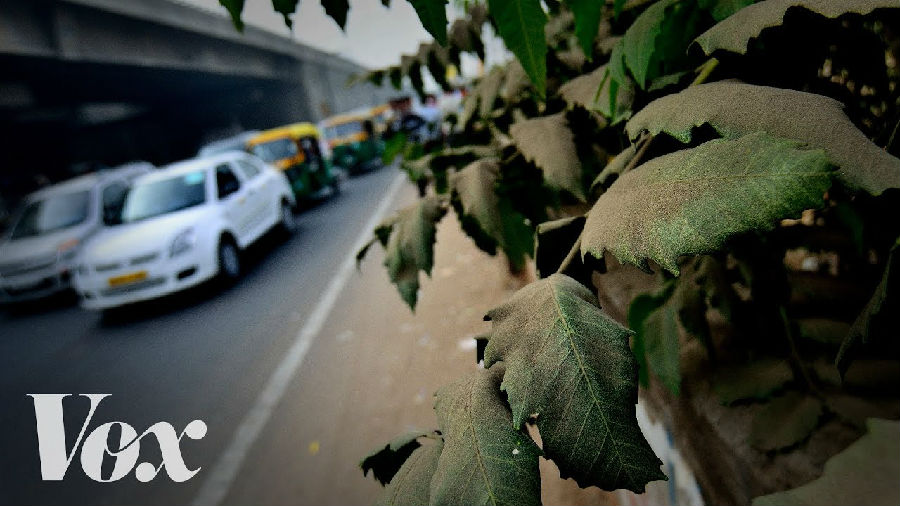Search Google Earth for China and you'll see this.
在谷歌地图上搜中国,你会看到这样的画面。
But an unedited satellite photo might look more like this.
然而,卫星照片未经处理时看起来可能更接近这样。
That gray smudge is air pollution and it's coming from Chinese cars, factories, and power plants.
那些灰色的污迹是空气污染,它们来自中国的汽车,工厂和发电厂。
But it's not only here.
但空气污染不止中国才有。
In cities around the world, air pollution is a big problem.
在世界各地的城市,空气污染都是一个严重的问题。
A majority of humans now live in cities and that number is only going to rise,
如今,大多数人都住进了城市,而且,这一数字只会越来越多,
which means more cars, more factories, and more power plants.
这也就意味着汽车越来越多,工厂越来越多,发电厂也越来越多。
As officials explore options for fighting air pollution, there is one tool that is often overlooked: trees.
官员寻求对抗空气污染的办法时,往往会忽视一个重要的办法:树木。
Cities are centers of industry, but the resulting pollution is filling our lungs and making us sick.
城市是工业中心,但工业发展带来的污染正在堵塞我们的肺,破坏我们的健康。
One major culprit is particulate matter: airborne particles of dust, soot and smoke that are released when we burn fossil fuels or kicked up during construction and farming.
罪魁祸首之一就是颗粒物质:燃烧化石燃料产生的或者施工,耕种时被扬起之后悬浮在空气中的烟灰烟雾颗粒。
When we inhale them, they can cause asthma and they can also enter our bloodstream to cause strokes and even death.
这些颗粒被吸入人体会引发哮喘,进入血液循环还会引起中风甚至死亡。
Experts estimate that outdoor air pollution kills over three million people a year
专家估计,每年室外空气污染造成的死亡人数超过300万,
and as cities grow, leaders are funding creative—and often expensive—solutions for the problem.
随着城市的发展,领导人们也已经拨款寻求能够创造性地解决这一问题——通常也较昂贵——的办法。
In London, the mayor spent over a million pounds spraying city streets with an adhesive that was supposed to glue pollutants to the road.
在往城市街道上喷据说能够将污染物粘在道路上的粘合剂上,伦敦市的市长就拨了一百多万英镑。
and in the Netherlands, designers have created a giant air purifier they call "The Smog Free Tower", which is cool.
荷兰的设计师则研发出了一个巨大的空气净化器,他们称之为“无烟塔”,这个办法是不错。
But there is another, simpler solution.
但其实,我们还有一种更简单的办法。
A new report from The Nature Conservancy shows that planting trees can be a cost-effective way to improve public health, which they do in two ways:
大自然保护协会最近的报告显示,植树是一种经济有效的改善公众健康的办法。其作用有两个。
First, a tree removes particulate matter when polluted air blows through its branches.
一是受污染的空气吹过树枝时,树木能够带走颗粒物质。

The particulate matter settles on the leaves and when it rains the dust is washed down the gutter so we don't inhale it.
颗粒附着在树叶上,下雨时,灰尘就会被冲到排水沟里,从而避免被人体吸入。
Second, trees cool temperatures by providing shade and releasing water through photosynthesis,
其次,树木能遮阴降温,进行光合作用还能产生水,
which cools summer temperatures by about two to four degrees fahrenheit.
夏季是能够将空气温度降低约2到4华氏度。
But there is a catch!
但是这个办法也有一个问题!
Trees can only clean and cool the air within a close radius: about one hundred feet,
树木只能清洁并降低一定距离范围内空气的温度:这个距离大约为一百英尺,
so city officials need to be careful where they plant.
所以城市官员种树时需要仔细考虑种树的位置。
Officials can maximize pollution reduction by planting trees where population density and air pollution overlap.
在人口密度大,空气污染严重的地方种树能够最大限度地减少污染。
The Nature Conservancy report uses data from Washington D.C. to create a map showing where planting trees will have the highest return on investment.
大自然保护协会的报告使用华盛顿特区的数据绘制了一张地图,地图显示了在哪些地方种树投入产出比最高。
And some trees work better than others: trees with larger, stickier leaves, like maples and elms are more effective,
此外,种某些树比种其他树的防污染效果更好:枫树和榆树等叶片更大,粘性更强的树防污染的效果更好,
but they also need to be considered within the larger ecosystem.
但我们也还是需要将这一点纳入更大的生态系统中加以考虑。
Compared to DC, many cities around the world have even more to gain from planting trees:
放眼全球,种树给其他城市带来的好处比特区还要多:
this map shows where return on investment is highest for reducing particulate matter.
这张地图显示了种树减少颗粒物质投入产出比最高的一些地方。
With proper targeting, planting trees can be just as cost-effective as other strategies,
只要定位得当,种树也可以和其他抗污染策略一样经济,
like converting public transportation to use less diesel fuel.
例如减少公共交柴油的用量。
But there is one major limiting factor: water access.
然而,还有一个主要的阻碍:水资源。
What might work in Boston, will be less feasible in a city like Doha, Qatar, where water is a scarce resource.
在波士顿可行的办法到了水资源稀缺的卡塔尔首都多哈就局限得多。
And on top of that, many mayors don't yet think of trees as a public health resource.
而且,许多市长并不认为树木也是公共卫生资源。
Trees might not look like giant air filters, but that's exactly what they are,
树木或许看起来不像什么巨型空气过滤器,但它们的本质的确如此,
and the sooner we start thinking of them that way,
越早认识到这一点,
the sooner the air we breathe might be cooler and cleaner in cities around the world.
我们就能越早呼吸到清洁、凉爽的空气。











